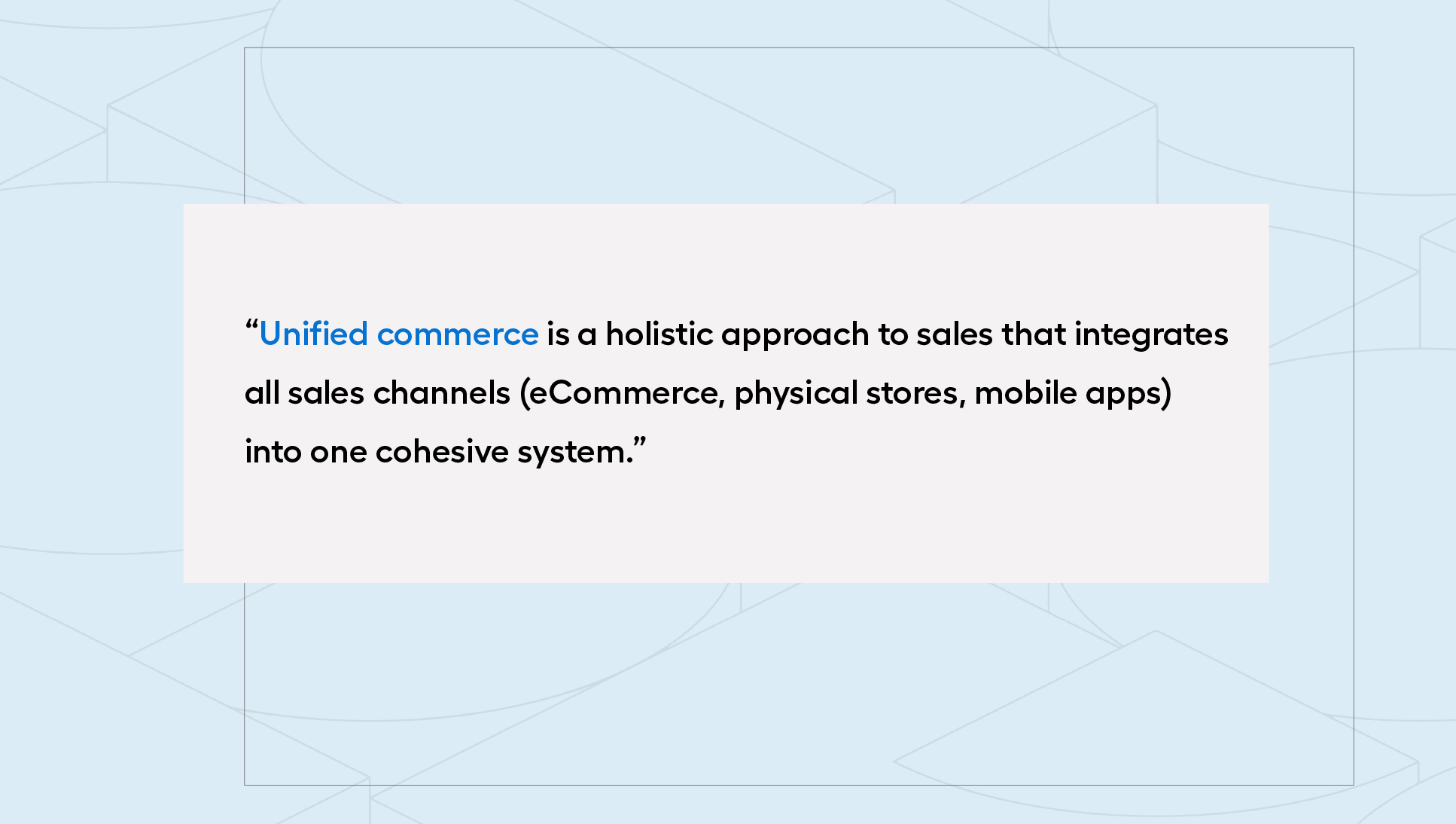Guide to unified commerce - how to effectively integrate all sales channels?
Table of contents
- Unified commerce - what is it?
- What areas does unified commerce connect?
- What does unified commerce look like in practice?
- Multichannel, Omnichannel, Unified Commerce - how to sell online most effectively?
- Why will unified commerce be the most effective sales strategy?
- Unified commerce - nowość czy branżowy standard?
Customers don't stick to a specific sales channel - they want to buy where and how it's convenient for them. Therefore, as the owner of an online store, you should ensure consistent shopping experiences for them, whether they choose to shop online, in a physical store, or through a mobile app. The answer to this challenge is unified commerce - a strategy that not only ensures consistency for customers but also allows managing all sales channels within one integrated system. Do you see an opportunity in this sales model to increase your business efficiency?
In the next part of the article, you will learn more about unified commerce and how to leverage this model to achieve success in eCommerce. Stay tuned!
Unified commerce - what is it?
Unified commerce is a strategy that focuses on connecting all sales channels. Its goal is to provide consistent experiences for customers and streamline the management of all internal processes within the store. With unified commerce, customers can enjoy seamless shopping, regardless of the chosen sales channel, and stores can more efficiently manage their inventory, logistics, and customer service.
In practice, this means that a customer shopping online, via a mobile app, on a marketplace, or in a physical store experiences a uniform service. For example, they can browse products on a computer, place an order in the app, and then pick it up in a physical store. Importantly, all information related to this transaction is available in real time to employees at all points of contact. This enables fast and efficient customer service, minimises errors, and better tailors the offer to individual customer preferences.

Unified commerce, in other words, is a holistic approach to sales that integrates all sales channels into one cohesive system. This ensures that all data related to customers, inventory, payments, and orders is available in real-time on a single platform.
What areas does unified commerce connect?
Unified commerce should be thought of globally - it's a series of actions united by one goal: the cohesion of an online store for both customers and managers. The strategy combines both the customer-facing part of the store and the management tools for employees into one system. This way, all data and functions are available in one place.
Key sales channels and tools that unified commerce connects include:
- eCommerce platform - the central point of managing the online store,
- marketplaces (e.g., Allegro, Amazon, or eBay),
- social media,
- mobile app,
- systems supporting retail sales (POS),
- external management systems (e.g., ERP, CMS, WMS),
- business support tools (for process automation, marketing support, or data analysis).
Unified commerce is a flexible strategy that can be tailored to the specific needs of each online store and expanded according to the business structure. This allows for effective responses to the dynamically changing market needs and customer expectations.
What does unified commerce look like in practice?
You already know the theory behind unified commerce, but to fully grasp its concept, it's best to use real-life examples from the industry. Unified commerce in an online store involves a range of activities, from technical platform integrations to developing a vision for a unified loyalty program. See what actions well-known brands are taking to achieve success through unified commerce.
In the app of the Polish clothing retail chain Reserved, users can check the history of all their purchases. The customer can see which purchases were made in-store, which were made through the sales platform, and which were made in the app. The app also allows customers to manage orders, such as making returns and choosing the preferred method (in-store or online - via courier or parcel locker). Other features of the app that support unified commerce include: a loyalty card that can be scanned for in-store purchases (points are immediately visible in the customer's online account) and the ability to scan a product tag to check its availability in the app, for example, when the desired size is not available in-store.

Rossmann, a drugstore chain, has gone a step further - customers can make their in-store purchases entirely on their smartphones. With the app, customers shopping at the drugstore can scan products with their phones and pay for their order, bypassing the cashier or self-service kiosks, saving time and providing greater convenience. Similar solutions are offered by other well-known brands like IKEA, Empik, and Carrefour.
An important element from the customer's perspective is the method of payment. Poles are increasingly embracing new payment innovations such as deferred payments. According to CRIF research, in 2023, the popularity of this method increased by over 40%, and the total amount of deferred transactions exceeded 400 million PLN. Initially, this payment method was only available online, but now more and more stores are introducing deferred payments in physical stores as well. The shoe chain CCC has partnered with PayPo, allowing in-store customers to also buy with deferred payments - they simply generate a special code in the store's app and show it to the cashier.
Multichannel, Omnichannel, Unified Commerce - how to sell online most effectively?
If you've been in the eCommerce industry for some time, you've likely noticed the growing popularity of new buzzwords each year. Initially, we talked about multichannel, then came the era of omnichannel, and now everyone is discussing unified commerce. All these strategies share a common goal: to provide the best possible customer experiences and to align perfectly with their current market expectations. However, it’s fair to say that none of these strategies radically change the eCommerce landscape - they are rather natural progressions of previous approaches. Let's trace the evolution of online sales strategy over recent years.

Multichannel - this approach centers on the product and focuses on its distribution across multiple channels. Customers can access the store's offerings both online, on a marketplace platform (e.g., Amazon), and in physical brand stores. However, each of these channels operates independently, meaning that customer and order data can vary depending on where the transaction occurs. While shoppers have access to different touchpoints with the brand, their experiences can be inconsistent because the backend systems are not interconnected.
Omnichannel - a step further in integrating sales channels, this approach focuses not only on the product but also on the customers. Omnichannel connects all touchpoints, enabling seamless transitions between them. Shoppers can start their shopping journey in one channel and finish it in another, such as buying a product online and returning it in a physical store. Although omnichannel offers more personalized and coordinated experiences, the systems often operate independently and are not fully synchronized on the backend. This means that data is not always updated in real-time, which can affect service quality.
Unified commerce - this is the most advanced sales strategy so far, enhancing previous approaches by fully integrating all sales systems into one transparent environment. This eliminates the problem of data inconsistency. All information about products, inventory, orders, and customers is exchanged in real-time, ensuring consistent communication across all touchpoints (e.g., a customer can receive notifications in the app about the status change of an order placed on the platform). This ensures that customers enjoy a cohesive shopping experience regardless of the chosen channel, and companies can efficiently manage their processes.
Why will unified commerce be the most effective sales strategy?
Online stores are constantly searching for strategies to increase sales, improve customer satisfaction, and build a competitive advantage. Unified commerce is a strategy that can fulfill each of these goals. Integrating all sales channels into one system brings several benefits, such as:
- Increased efficiency - integrating all channels automates many tasks and processes, saving time and resources. This also streamlines supply chain and logistics management, leading to reduced costs and increased productivity.
- Greater scalability - unified commerce makes it easier to expand into new markets, both domestic and international. An example of leveraging this strategy is implementing the multi store feature on the Magento platform, which allows for the easy addition of new languages, currencies, and regions, making the store more accessible to global customers.
- Deeper customer understanding - viewing the customer holistically across multiple channels allows for the personalization of offers, recommendations, and communication, leading to increased customer satisfaction and loyalty.
- Enhanced data analysis - unified commerce provides access to rich analytical data from various sources, enabling a better understanding of marketing campaign effectiveness, customer behaviors, and sales trends.
Unified commerce - nowość czy branżowy standard?
While it may seem that unified commerce is just another trend in eCommerce, behind this concept are actions that the industry has been taking for a long time. Integration of various sales channels, cohesive data management, and personalized customer experiences are elements that are well-known and widely practiced. Therefore, the significance of unified commerce should not be underestimated.
To fully harness the potential of unified commerce, it's important to note that the key to success lies not only in integrating technologies but also in aligning internal processes and business strategy. Consistency in implementing this strategy helps increase customer loyalty, improve operational efficiency, and respond more swiftly to market changes, which are key to long-term success in online business.







